Financial Analysis of Roast Ltd: Performance, Investment, and Ratios
VerifiedAdded on 2023/01/16
|13
|4191
|69
Report
AI Summary
This report provides a comprehensive financial analysis of Roast Ltd, a UK coffee house, assessing its performance and attractiveness for potential acquisition. The analysis includes an industry review, a detailed examination of the company's financial statements (profit and loss, financial position, and cash flow), and the calculation of key financial ratios such as gross profit, operating profit, net profit, debt-equity, current, quick, and operating cash cycle. The report evaluates the company's profitability, liquidity, and solvency, and assesses the financial impact of a proposed investment using techniques like Net Present Value (NPV), Accounting Rate of Return (ARR), and payback period. The report also recommends financial strategies, such as securing a bank loan, to facilitate project goals. Findings reveal that while the company's performance improved from 2017 to 2018 in terms of profitability, its liquidity declined. The operating cash cycle increased, suggesting a longer time to convert current assets to cash, which may indicate potential financial challenges.

Financial Decision
Making
Making
Paraphrase This Document
Need a fresh take? Get an instant paraphrase of this document with our AI Paraphraser
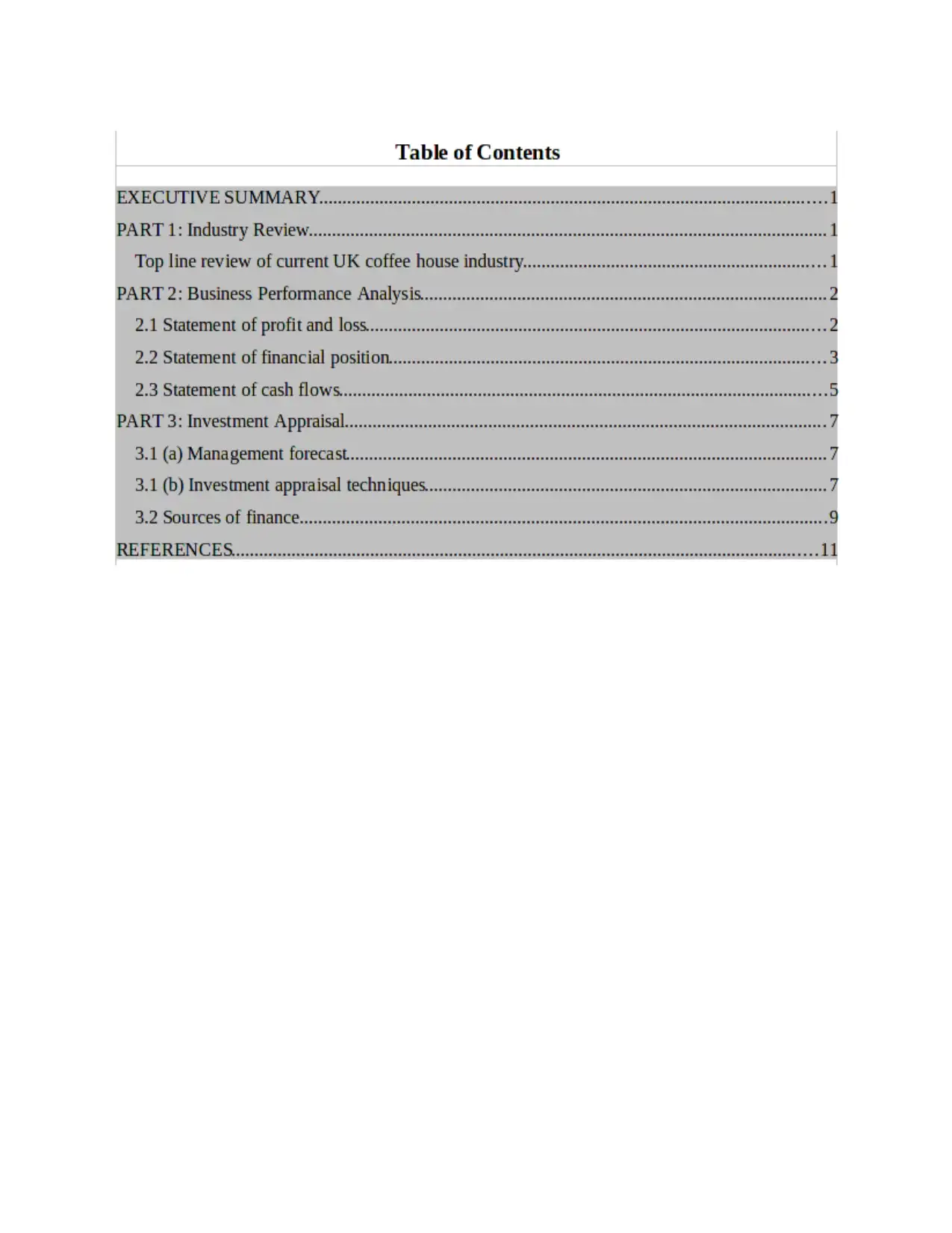
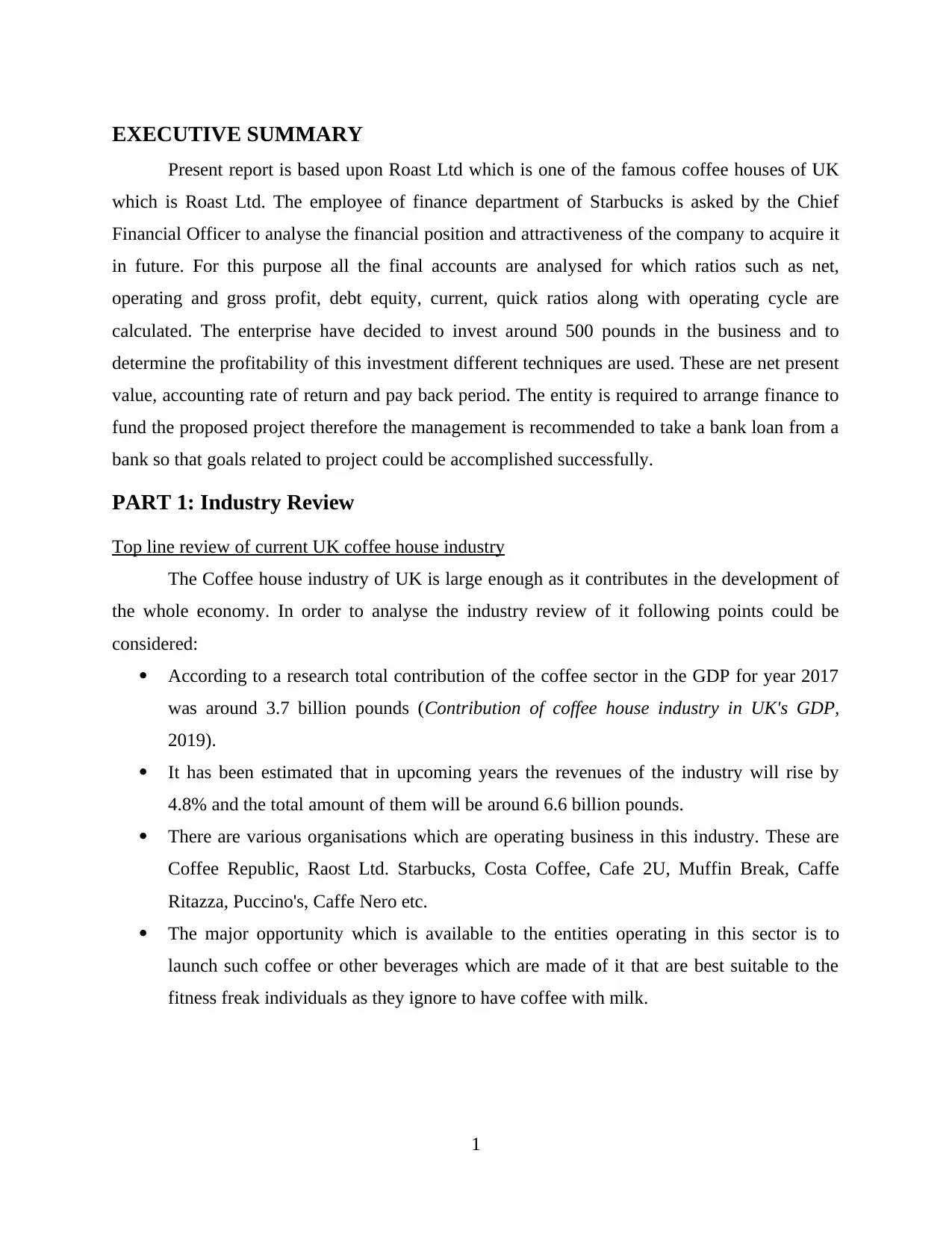
EXECUTIVE SUMMARY
Present report is based upon Roast Ltd which is one of the famous coffee houses of UK
which is Roast Ltd. The employee of finance department of Starbucks is asked by the Chief
Financial Officer to analyse the financial position and attractiveness of the company to acquire it
in future. For this purpose all the final accounts are analysed for which ratios such as net,
operating and gross profit, debt equity, current, quick ratios along with operating cycle are
calculated. The enterprise have decided to invest around 500 pounds in the business and to
determine the profitability of this investment different techniques are used. These are net present
value, accounting rate of return and pay back period. The entity is required to arrange finance to
fund the proposed project therefore the management is recommended to take a bank loan from a
bank so that goals related to project could be accomplished successfully.
PART 1: Industry Review
Top line review of current UK coffee house industry
The Coffee house industry of UK is large enough as it contributes in the development of
the whole economy. In order to analyse the industry review of it following points could be
considered:
According to a research total contribution of the coffee sector in the GDP for year 2017
was around 3.7 billion pounds (Contribution of coffee house industry in UK's GDP,
2019).
It has been estimated that in upcoming years the revenues of the industry will rise by
4.8% and the total amount of them will be around 6.6 billion pounds.
There are various organisations which are operating business in this industry. These are
Coffee Republic, Raost Ltd. Starbucks, Costa Coffee, Cafe 2U, Muffin Break, Caffe
Ritazza, Puccino's, Caffe Nero etc.
The major opportunity which is available to the entities operating in this sector is to
launch such coffee or other beverages which are made of it that are best suitable to the
fitness freak individuals as they ignore to have coffee with milk.
1
Present report is based upon Roast Ltd which is one of the famous coffee houses of UK
which is Roast Ltd. The employee of finance department of Starbucks is asked by the Chief
Financial Officer to analyse the financial position and attractiveness of the company to acquire it
in future. For this purpose all the final accounts are analysed for which ratios such as net,
operating and gross profit, debt equity, current, quick ratios along with operating cycle are
calculated. The enterprise have decided to invest around 500 pounds in the business and to
determine the profitability of this investment different techniques are used. These are net present
value, accounting rate of return and pay back period. The entity is required to arrange finance to
fund the proposed project therefore the management is recommended to take a bank loan from a
bank so that goals related to project could be accomplished successfully.
PART 1: Industry Review
Top line review of current UK coffee house industry
The Coffee house industry of UK is large enough as it contributes in the development of
the whole economy. In order to analyse the industry review of it following points could be
considered:
According to a research total contribution of the coffee sector in the GDP for year 2017
was around 3.7 billion pounds (Contribution of coffee house industry in UK's GDP,
2019).
It has been estimated that in upcoming years the revenues of the industry will rise by
4.8% and the total amount of them will be around 6.6 billion pounds.
There are various organisations which are operating business in this industry. These are
Coffee Republic, Raost Ltd. Starbucks, Costa Coffee, Cafe 2U, Muffin Break, Caffe
Ritazza, Puccino's, Caffe Nero etc.
The major opportunity which is available to the entities operating in this sector is to
launch such coffee or other beverages which are made of it that are best suitable to the
fitness freak individuals as they ignore to have coffee with milk.
1
⊘ This is a preview!⊘
Do you want full access?
Subscribe today to unlock all pages.

Trusted by 1+ million students worldwide
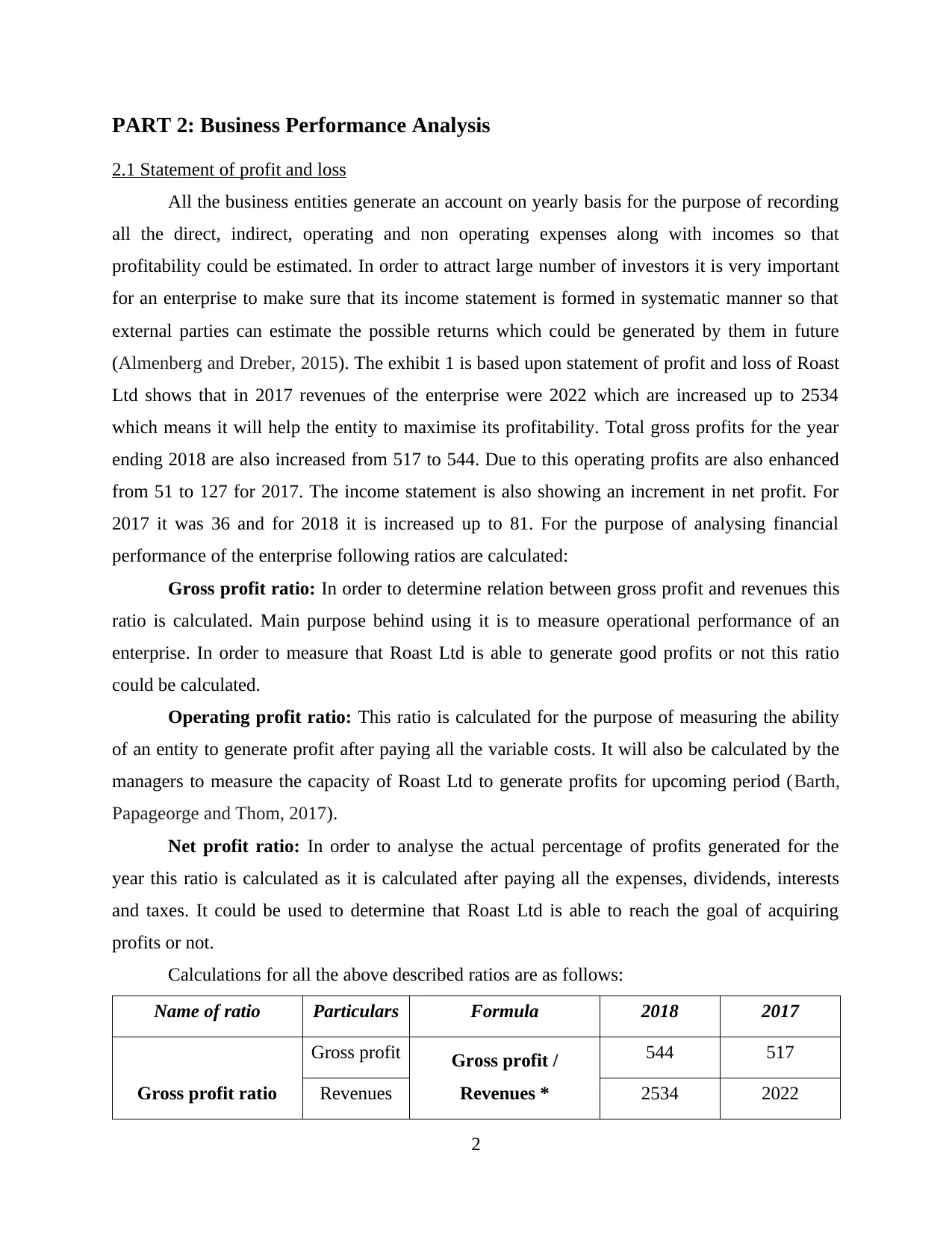
PART 2: Business Performance Analysis
2.1 Statement of profit and loss
All the business entities generate an account on yearly basis for the purpose of recording
all the direct, indirect, operating and non operating expenses along with incomes so that
profitability could be estimated. In order to attract large number of investors it is very important
for an enterprise to make sure that its income statement is formed in systematic manner so that
external parties can estimate the possible returns which could be generated by them in future
(Almenberg and Dreber, 2015). The exhibit 1 is based upon statement of profit and loss of Roast
Ltd shows that in 2017 revenues of the enterprise were 2022 which are increased up to 2534
which means it will help the entity to maximise its profitability. Total gross profits for the year
ending 2018 are also increased from 517 to 544. Due to this operating profits are also enhanced
from 51 to 127 for 2017. The income statement is also showing an increment in net profit. For
2017 it was 36 and for 2018 it is increased up to 81. For the purpose of analysing financial
performance of the enterprise following ratios are calculated:
Gross profit ratio: In order to determine relation between gross profit and revenues this
ratio is calculated. Main purpose behind using it is to measure operational performance of an
enterprise. In order to measure that Roast Ltd is able to generate good profits or not this ratio
could be calculated.
Operating profit ratio: This ratio is calculated for the purpose of measuring the ability
of an entity to generate profit after paying all the variable costs. It will also be calculated by the
managers to measure the capacity of Roast Ltd to generate profits for upcoming period (Barth,
Papageorge and Thom, 2017).
Net profit ratio: In order to analyse the actual percentage of profits generated for the
year this ratio is calculated as it is calculated after paying all the expenses, dividends, interests
and taxes. It could be used to determine that Roast Ltd is able to reach the goal of acquiring
profits or not.
Calculations for all the above described ratios are as follows:
Name of ratio Particulars Formula 2018 2017
Gross profit ratio
Gross profit Gross profit /
Revenues *
544 517
Revenues 2534 2022
2
2.1 Statement of profit and loss
All the business entities generate an account on yearly basis for the purpose of recording
all the direct, indirect, operating and non operating expenses along with incomes so that
profitability could be estimated. In order to attract large number of investors it is very important
for an enterprise to make sure that its income statement is formed in systematic manner so that
external parties can estimate the possible returns which could be generated by them in future
(Almenberg and Dreber, 2015). The exhibit 1 is based upon statement of profit and loss of Roast
Ltd shows that in 2017 revenues of the enterprise were 2022 which are increased up to 2534
which means it will help the entity to maximise its profitability. Total gross profits for the year
ending 2018 are also increased from 517 to 544. Due to this operating profits are also enhanced
from 51 to 127 for 2017. The income statement is also showing an increment in net profit. For
2017 it was 36 and for 2018 it is increased up to 81. For the purpose of analysing financial
performance of the enterprise following ratios are calculated:
Gross profit ratio: In order to determine relation between gross profit and revenues this
ratio is calculated. Main purpose behind using it is to measure operational performance of an
enterprise. In order to measure that Roast Ltd is able to generate good profits or not this ratio
could be calculated.
Operating profit ratio: This ratio is calculated for the purpose of measuring the ability
of an entity to generate profit after paying all the variable costs. It will also be calculated by the
managers to measure the capacity of Roast Ltd to generate profits for upcoming period (Barth,
Papageorge and Thom, 2017).
Net profit ratio: In order to analyse the actual percentage of profits generated for the
year this ratio is calculated as it is calculated after paying all the expenses, dividends, interests
and taxes. It could be used to determine that Roast Ltd is able to reach the goal of acquiring
profits or not.
Calculations for all the above described ratios are as follows:
Name of ratio Particulars Formula 2018 2017
Gross profit ratio
Gross profit Gross profit /
Revenues *
544 517
Revenues 2534 2022
2
Paraphrase This Document
Need a fresh take? Get an instant paraphrase of this document with our AI Paraphraser
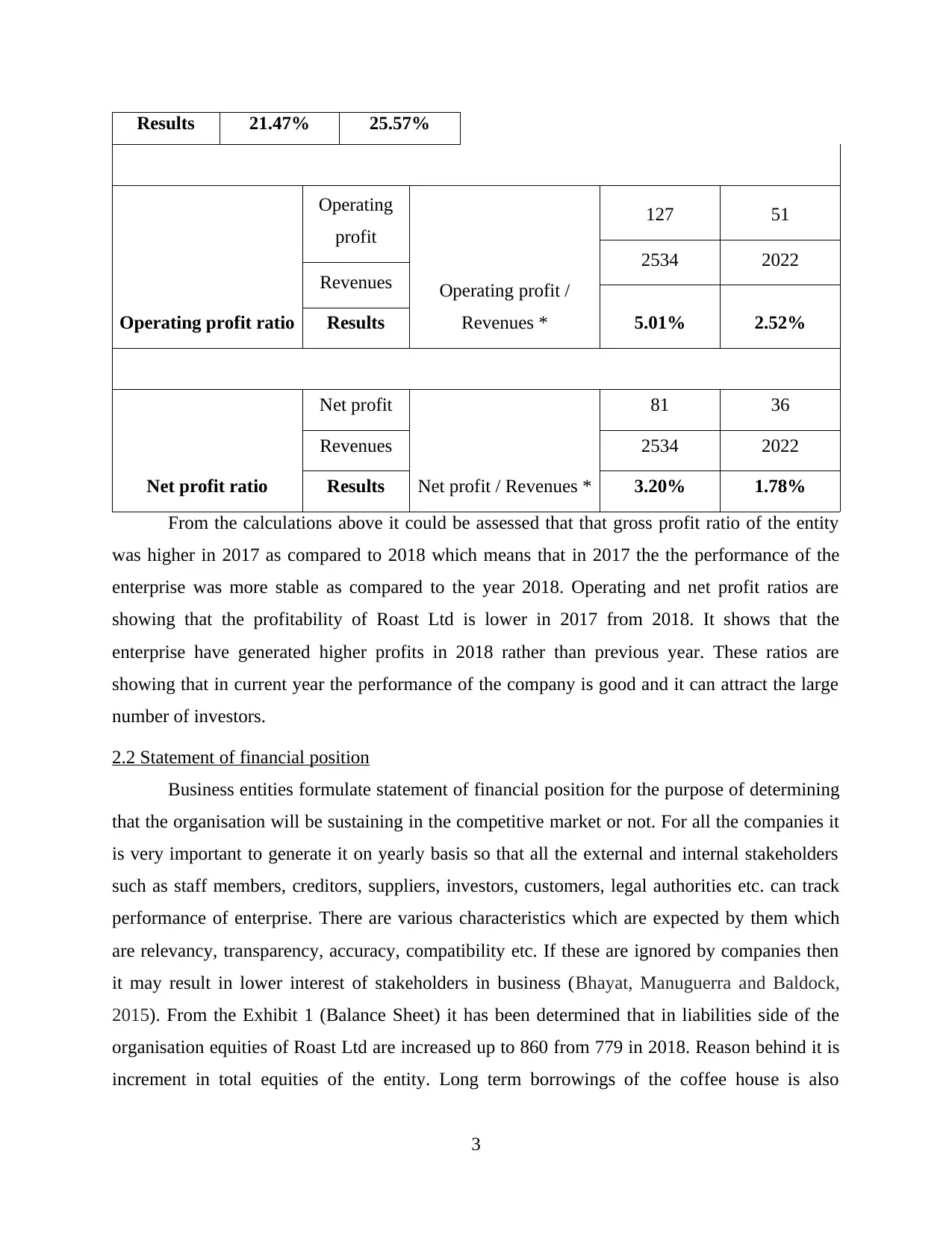
Results 21.47% 25.57%
Operating profit ratio
Operating
profit
Operating profit /
Revenues *
127 51
2534 2022
Revenues
5.01% 2.52%Results
Net profit ratio
Net profit
Net profit / Revenues *
81 36
Revenues 2534 2022
Results 3.20% 1.78%
From the calculations above it could be assessed that that gross profit ratio of the entity
was higher in 2017 as compared to 2018 which means that in 2017 the the performance of the
enterprise was more stable as compared to the year 2018. Operating and net profit ratios are
showing that the profitability of Roast Ltd is lower in 2017 from 2018. It shows that the
enterprise have generated higher profits in 2018 rather than previous year. These ratios are
showing that in current year the performance of the company is good and it can attract the large
number of investors.
2.2 Statement of financial position
Business entities formulate statement of financial position for the purpose of determining
that the organisation will be sustaining in the competitive market or not. For all the companies it
is very important to generate it on yearly basis so that all the external and internal stakeholders
such as staff members, creditors, suppliers, investors, customers, legal authorities etc. can track
performance of enterprise. There are various characteristics which are expected by them which
are relevancy, transparency, accuracy, compatibility etc. If these are ignored by companies then
it may result in lower interest of stakeholders in business (Bhayat, Manuguerra and Baldock,
2015). From the Exhibit 1 (Balance Sheet) it has been determined that in liabilities side of the
organisation equities of Roast Ltd are increased up to 860 from 779 in 2018. Reason behind it is
increment in total equities of the entity. Long term borrowings of the coffee house is also
3
Operating profit ratio
Operating
profit
Operating profit /
Revenues *
127 51
2534 2022
Revenues
5.01% 2.52%Results
Net profit ratio
Net profit
Net profit / Revenues *
81 36
Revenues 2534 2022
Results 3.20% 1.78%
From the calculations above it could be assessed that that gross profit ratio of the entity
was higher in 2017 as compared to 2018 which means that in 2017 the the performance of the
enterprise was more stable as compared to the year 2018. Operating and net profit ratios are
showing that the profitability of Roast Ltd is lower in 2017 from 2018. It shows that the
enterprise have generated higher profits in 2018 rather than previous year. These ratios are
showing that in current year the performance of the company is good and it can attract the large
number of investors.
2.2 Statement of financial position
Business entities formulate statement of financial position for the purpose of determining
that the organisation will be sustaining in the competitive market or not. For all the companies it
is very important to generate it on yearly basis so that all the external and internal stakeholders
such as staff members, creditors, suppliers, investors, customers, legal authorities etc. can track
performance of enterprise. There are various characteristics which are expected by them which
are relevancy, transparency, accuracy, compatibility etc. If these are ignored by companies then
it may result in lower interest of stakeholders in business (Bhayat, Manuguerra and Baldock,
2015). From the Exhibit 1 (Balance Sheet) it has been determined that in liabilities side of the
organisation equities of Roast Ltd are increased up to 860 from 779 in 2018. Reason behind it is
increment in total equities of the entity. Long term borrowings of the coffee house is also
3
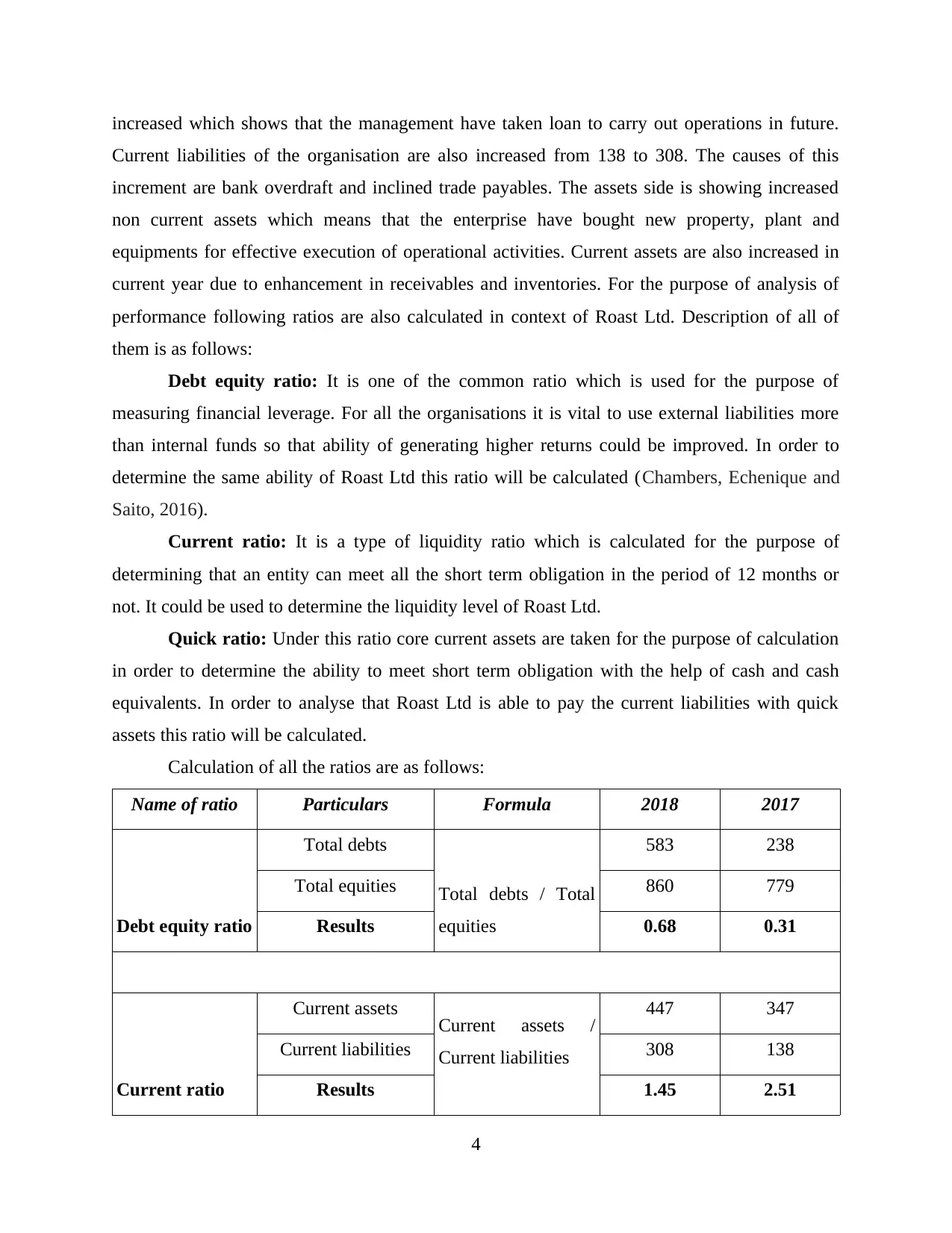
increased which shows that the management have taken loan to carry out operations in future.
Current liabilities of the organisation are also increased from 138 to 308. The causes of this
increment are bank overdraft and inclined trade payables. The assets side is showing increased
non current assets which means that the enterprise have bought new property, plant and
equipments for effective execution of operational activities. Current assets are also increased in
current year due to enhancement in receivables and inventories. For the purpose of analysis of
performance following ratios are also calculated in context of Roast Ltd. Description of all of
them is as follows:
Debt equity ratio: It is one of the common ratio which is used for the purpose of
measuring financial leverage. For all the organisations it is vital to use external liabilities more
than internal funds so that ability of generating higher returns could be improved. In order to
determine the same ability of Roast Ltd this ratio will be calculated (Chambers, Echenique and
Saito, 2016).
Current ratio: It is a type of liquidity ratio which is calculated for the purpose of
determining that an entity can meet all the short term obligation in the period of 12 months or
not. It could be used to determine the liquidity level of Roast Ltd.
Quick ratio: Under this ratio core current assets are taken for the purpose of calculation
in order to determine the ability to meet short term obligation with the help of cash and cash
equivalents. In order to analyse that Roast Ltd is able to pay the current liabilities with quick
assets this ratio will be calculated.
Calculation of all the ratios are as follows:
Name of ratio Particulars Formula 2018 2017
Debt equity ratio
Total debts
Total debts / Total
equities
583 238
Total equities 860 779
Results 0.68 0.31
Current ratio
Current assets Current assets /
Current liabilities
447 347
Current liabilities 308 138
Results 1.45 2.51
4
Current liabilities of the organisation are also increased from 138 to 308. The causes of this
increment are bank overdraft and inclined trade payables. The assets side is showing increased
non current assets which means that the enterprise have bought new property, plant and
equipments for effective execution of operational activities. Current assets are also increased in
current year due to enhancement in receivables and inventories. For the purpose of analysis of
performance following ratios are also calculated in context of Roast Ltd. Description of all of
them is as follows:
Debt equity ratio: It is one of the common ratio which is used for the purpose of
measuring financial leverage. For all the organisations it is vital to use external liabilities more
than internal funds so that ability of generating higher returns could be improved. In order to
determine the same ability of Roast Ltd this ratio will be calculated (Chambers, Echenique and
Saito, 2016).
Current ratio: It is a type of liquidity ratio which is calculated for the purpose of
determining that an entity can meet all the short term obligation in the period of 12 months or
not. It could be used to determine the liquidity level of Roast Ltd.
Quick ratio: Under this ratio core current assets are taken for the purpose of calculation
in order to determine the ability to meet short term obligation with the help of cash and cash
equivalents. In order to analyse that Roast Ltd is able to pay the current liabilities with quick
assets this ratio will be calculated.
Calculation of all the ratios are as follows:
Name of ratio Particulars Formula 2018 2017
Debt equity ratio
Total debts
Total debts / Total
equities
583 238
Total equities 860 779
Results 0.68 0.31
Current ratio
Current assets Current assets /
Current liabilities
447 347
Current liabilities 308 138
Results 1.45 2.51
4
⊘ This is a preview!⊘
Do you want full access?
Subscribe today to unlock all pages.

Trusted by 1+ million students worldwide
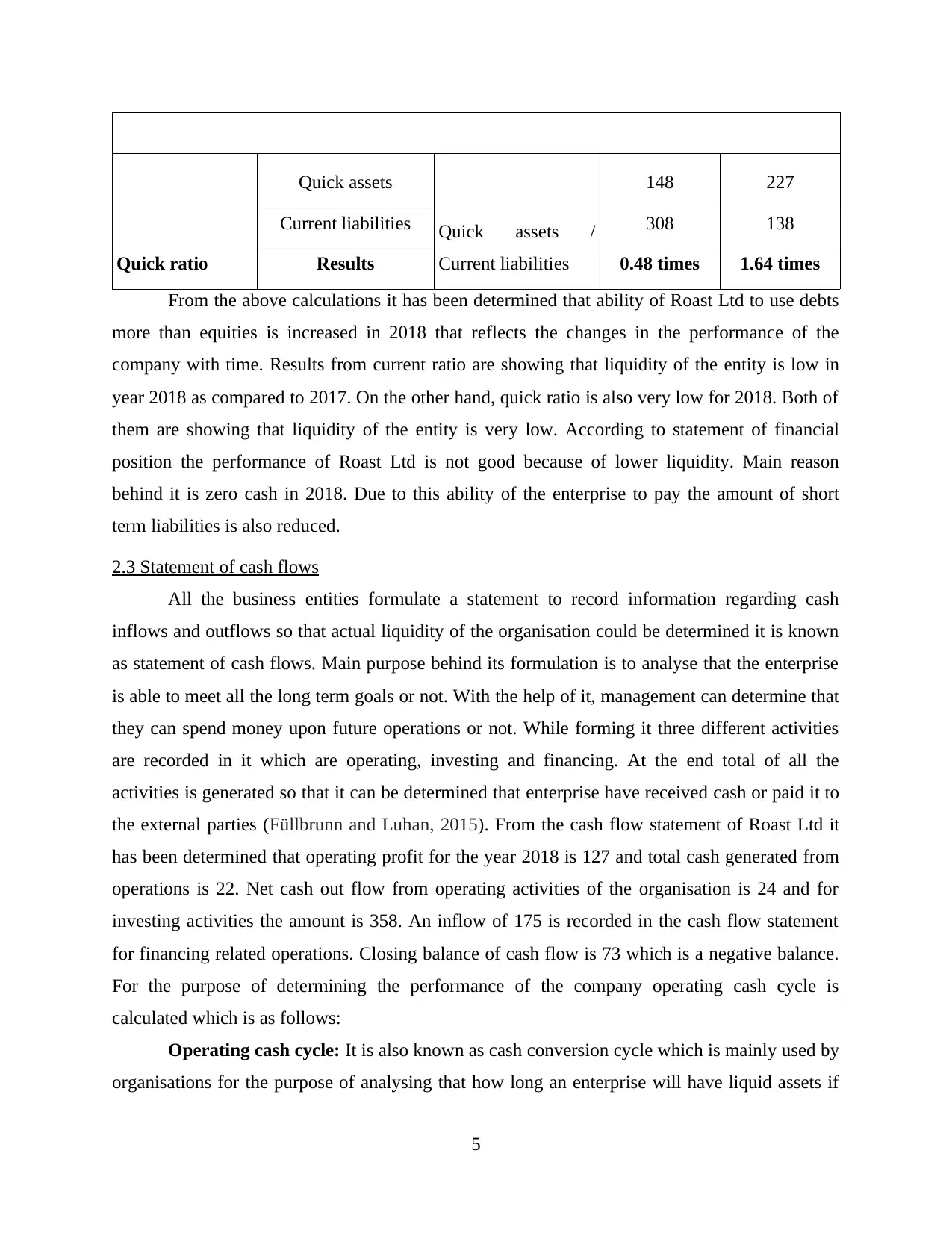
Quick ratio
Quick assets
Quick assets /
Current liabilities
148 227
Current liabilities 308 138
Results 0.48 times 1.64 times
From the above calculations it has been determined that ability of Roast Ltd to use debts
more than equities is increased in 2018 that reflects the changes in the performance of the
company with time. Results from current ratio are showing that liquidity of the entity is low in
year 2018 as compared to 2017. On the other hand, quick ratio is also very low for 2018. Both of
them are showing that liquidity of the entity is very low. According to statement of financial
position the performance of Roast Ltd is not good because of lower liquidity. Main reason
behind it is zero cash in 2018. Due to this ability of the enterprise to pay the amount of short
term liabilities is also reduced.
2.3 Statement of cash flows
All the business entities formulate a statement to record information regarding cash
inflows and outflows so that actual liquidity of the organisation could be determined it is known
as statement of cash flows. Main purpose behind its formulation is to analyse that the enterprise
is able to meet all the long term goals or not. With the help of it, management can determine that
they can spend money upon future operations or not. While forming it three different activities
are recorded in it which are operating, investing and financing. At the end total of all the
activities is generated so that it can be determined that enterprise have received cash or paid it to
the external parties (Füllbrunn and Luhan, 2015). From the cash flow statement of Roast Ltd it
has been determined that operating profit for the year 2018 is 127 and total cash generated from
operations is 22. Net cash out flow from operating activities of the organisation is 24 and for
investing activities the amount is 358. An inflow of 175 is recorded in the cash flow statement
for financing related operations. Closing balance of cash flow is 73 which is a negative balance.
For the purpose of determining the performance of the company operating cash cycle is
calculated which is as follows:
Operating cash cycle: It is also known as cash conversion cycle which is mainly used by
organisations for the purpose of analysing that how long an enterprise will have liquid assets if
5
Quick assets
Quick assets /
Current liabilities
148 227
Current liabilities 308 138
Results 0.48 times 1.64 times
From the above calculations it has been determined that ability of Roast Ltd to use debts
more than equities is increased in 2018 that reflects the changes in the performance of the
company with time. Results from current ratio are showing that liquidity of the entity is low in
year 2018 as compared to 2017. On the other hand, quick ratio is also very low for 2018. Both of
them are showing that liquidity of the entity is very low. According to statement of financial
position the performance of Roast Ltd is not good because of lower liquidity. Main reason
behind it is zero cash in 2018. Due to this ability of the enterprise to pay the amount of short
term liabilities is also reduced.
2.3 Statement of cash flows
All the business entities formulate a statement to record information regarding cash
inflows and outflows so that actual liquidity of the organisation could be determined it is known
as statement of cash flows. Main purpose behind its formulation is to analyse that the enterprise
is able to meet all the long term goals or not. With the help of it, management can determine that
they can spend money upon future operations or not. While forming it three different activities
are recorded in it which are operating, investing and financing. At the end total of all the
activities is generated so that it can be determined that enterprise have received cash or paid it to
the external parties (Füllbrunn and Luhan, 2015). From the cash flow statement of Roast Ltd it
has been determined that operating profit for the year 2018 is 127 and total cash generated from
operations is 22. Net cash out flow from operating activities of the organisation is 24 and for
investing activities the amount is 358. An inflow of 175 is recorded in the cash flow statement
for financing related operations. Closing balance of cash flow is 73 which is a negative balance.
For the purpose of determining the performance of the company operating cash cycle is
calculated which is as follows:
Operating cash cycle: It is also known as cash conversion cycle which is mainly used by
organisations for the purpose of analysing that how long an enterprise will have liquid assets if
5
Paraphrase This Document
Need a fresh take? Get an instant paraphrase of this document with our AI Paraphraser
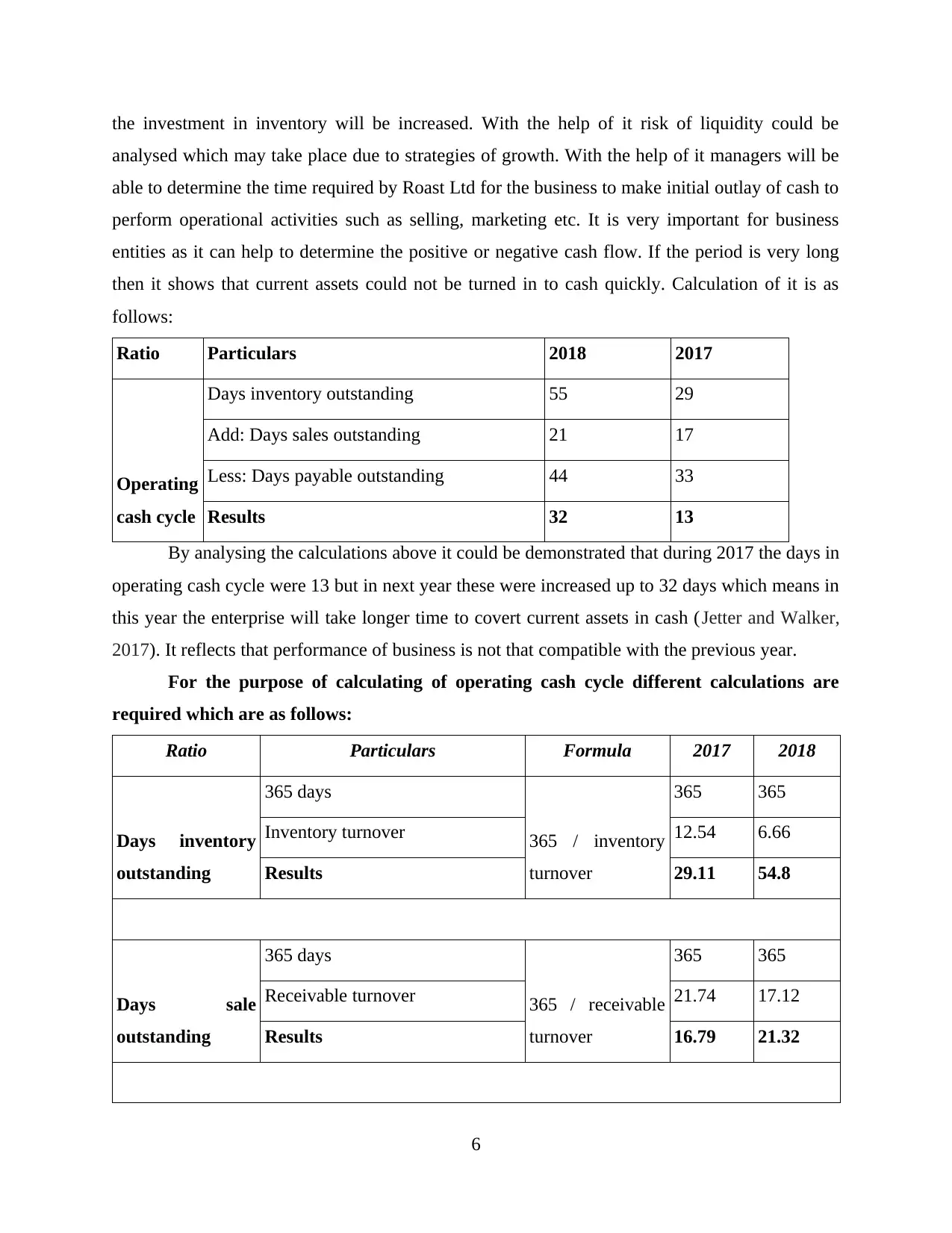
the investment in inventory will be increased. With the help of it risk of liquidity could be
analysed which may take place due to strategies of growth. With the help of it managers will be
able to determine the time required by Roast Ltd for the business to make initial outlay of cash to
perform operational activities such as selling, marketing etc. It is very important for business
entities as it can help to determine the positive or negative cash flow. If the period is very long
then it shows that current assets could not be turned in to cash quickly. Calculation of it is as
follows:
Ratio Particulars 2018 2017
Operating
cash cycle
Days inventory outstanding 55 29
Add: Days sales outstanding 21 17
Less: Days payable outstanding 44 33
Results 32 13
By analysing the calculations above it could be demonstrated that during 2017 the days in
operating cash cycle were 13 but in next year these were increased up to 32 days which means in
this year the enterprise will take longer time to covert current assets in cash (Jetter and Walker,
2017). It reflects that performance of business is not that compatible with the previous year.
For the purpose of calculating of operating cash cycle different calculations are
required which are as follows:
Ratio Particulars Formula 2017 2018
Days inventory
outstanding
365 days
365 / inventory
turnover
365 365
Inventory turnover 12.54 6.66
Results 29.11 54.8
Days sale
outstanding
365 days
365 / receivable
turnover
365 365
Receivable turnover 21.74 17.12
Results 16.79 21.32
6
analysed which may take place due to strategies of growth. With the help of it managers will be
able to determine the time required by Roast Ltd for the business to make initial outlay of cash to
perform operational activities such as selling, marketing etc. It is very important for business
entities as it can help to determine the positive or negative cash flow. If the period is very long
then it shows that current assets could not be turned in to cash quickly. Calculation of it is as
follows:
Ratio Particulars 2018 2017
Operating
cash cycle
Days inventory outstanding 55 29
Add: Days sales outstanding 21 17
Less: Days payable outstanding 44 33
Results 32 13
By analysing the calculations above it could be demonstrated that during 2017 the days in
operating cash cycle were 13 but in next year these were increased up to 32 days which means in
this year the enterprise will take longer time to covert current assets in cash (Jetter and Walker,
2017). It reflects that performance of business is not that compatible with the previous year.
For the purpose of calculating of operating cash cycle different calculations are
required which are as follows:
Ratio Particulars Formula 2017 2018
Days inventory
outstanding
365 days
365 / inventory
turnover
365 365
Inventory turnover 12.54 6.66
Results 29.11 54.8
Days sale
outstanding
365 days
365 / receivable
turnover
365 365
Receivable turnover 21.74 17.12
Results 16.79 21.32
6
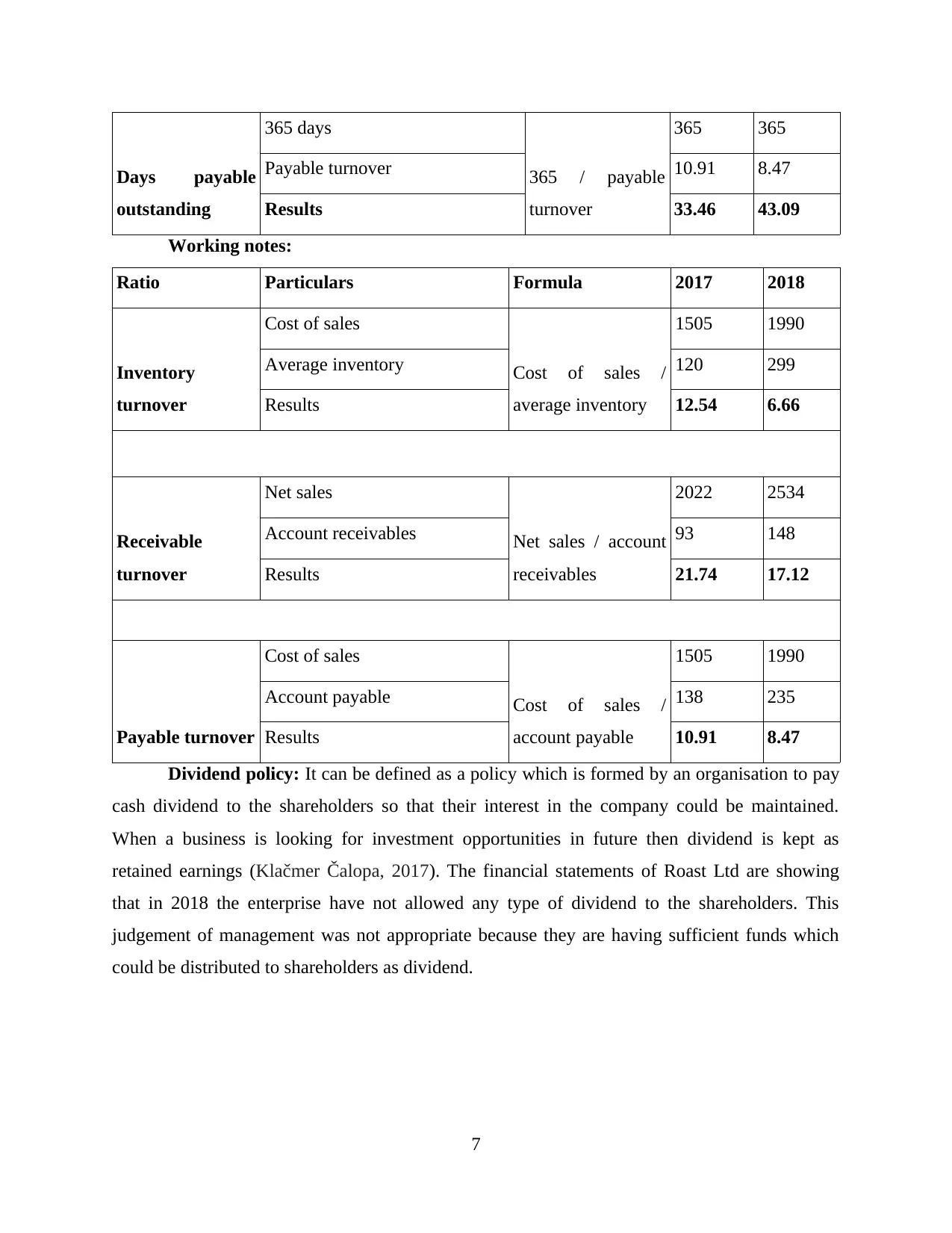
Days payable
outstanding
365 days
365 / payable
turnover
365 365
Payable turnover 10.91 8.47
Results 33.46 43.09
Working notes:
Ratio Particulars Formula 2017 2018
Inventory
turnover
Cost of sales
Cost of sales /
average inventory
1505 1990
Average inventory 120 299
Results 12.54 6.66
Receivable
turnover
Net sales
Net sales / account
receivables
2022 2534
Account receivables 93 148
Results 21.74 17.12
Payable turnover
Cost of sales
Cost of sales /
account payable
1505 1990
Account payable 138 235
Results 10.91 8.47
Dividend policy: It can be defined as a policy which is formed by an organisation to pay
cash dividend to the shareholders so that their interest in the company could be maintained.
When a business is looking for investment opportunities in future then dividend is kept as
retained earnings (Klačmer Čalopa, 2017). The financial statements of Roast Ltd are showing
that in 2018 the enterprise have not allowed any type of dividend to the shareholders. This
judgement of management was not appropriate because they are having sufficient funds which
could be distributed to shareholders as dividend.
7
outstanding
365 days
365 / payable
turnover
365 365
Payable turnover 10.91 8.47
Results 33.46 43.09
Working notes:
Ratio Particulars Formula 2017 2018
Inventory
turnover
Cost of sales
Cost of sales /
average inventory
1505 1990
Average inventory 120 299
Results 12.54 6.66
Receivable
turnover
Net sales
Net sales / account
receivables
2022 2534
Account receivables 93 148
Results 21.74 17.12
Payable turnover
Cost of sales
Cost of sales /
account payable
1505 1990
Account payable 138 235
Results 10.91 8.47
Dividend policy: It can be defined as a policy which is formed by an organisation to pay
cash dividend to the shareholders so that their interest in the company could be maintained.
When a business is looking for investment opportunities in future then dividend is kept as
retained earnings (Klačmer Čalopa, 2017). The financial statements of Roast Ltd are showing
that in 2018 the enterprise have not allowed any type of dividend to the shareholders. This
judgement of management was not appropriate because they are having sufficient funds which
could be distributed to shareholders as dividend.
7
⊘ This is a preview!⊘
Do you want full access?
Subscribe today to unlock all pages.

Trusted by 1+ million students worldwide
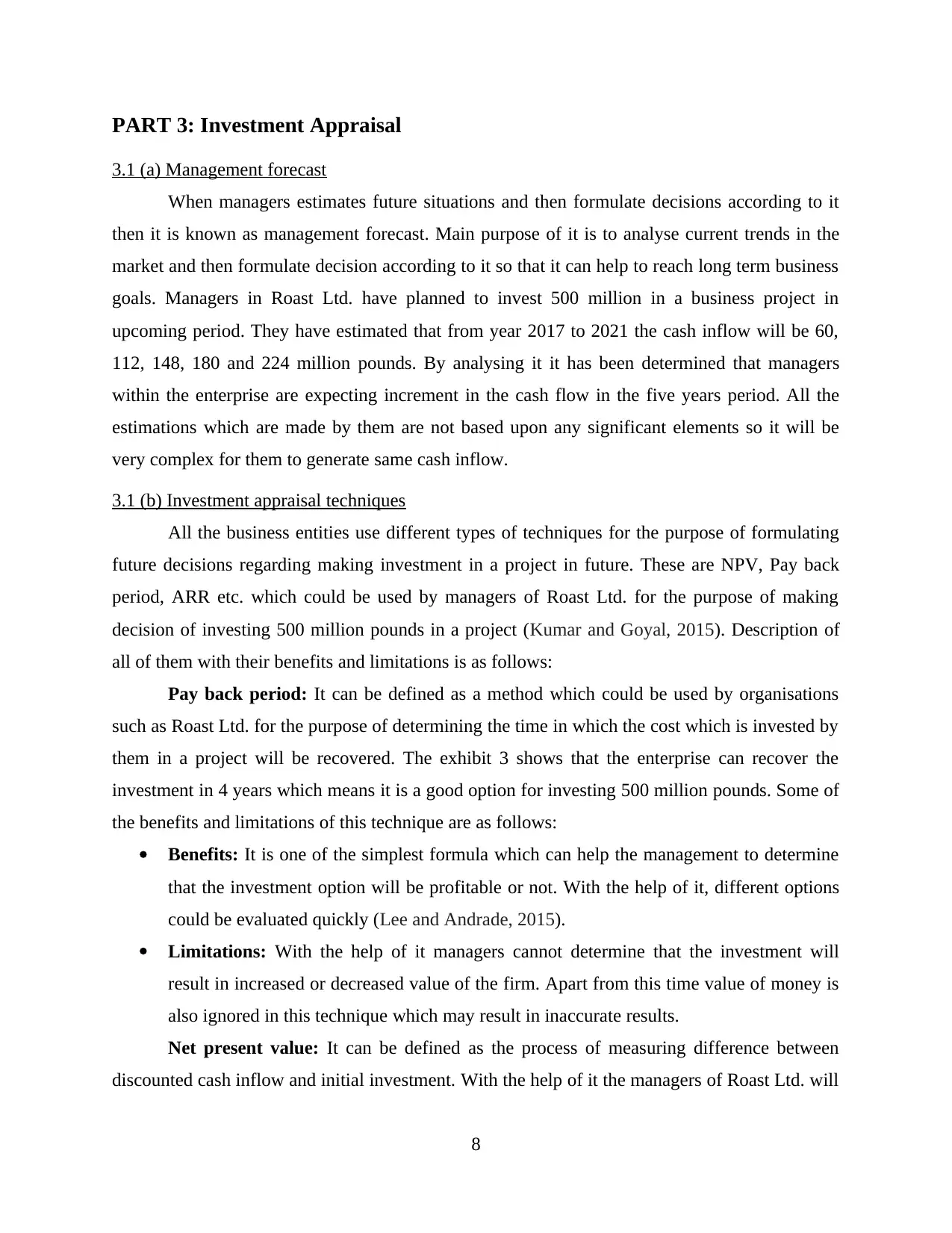
PART 3: Investment Appraisal
3.1 (a) Management forecast
When managers estimates future situations and then formulate decisions according to it
then it is known as management forecast. Main purpose of it is to analyse current trends in the
market and then formulate decision according to it so that it can help to reach long term business
goals. Managers in Roast Ltd. have planned to invest 500 million in a business project in
upcoming period. They have estimated that from year 2017 to 2021 the cash inflow will be 60,
112, 148, 180 and 224 million pounds. By analysing it it has been determined that managers
within the enterprise are expecting increment in the cash flow in the five years period. All the
estimations which are made by them are not based upon any significant elements so it will be
very complex for them to generate same cash inflow.
3.1 (b) Investment appraisal techniques
All the business entities use different types of techniques for the purpose of formulating
future decisions regarding making investment in a project in future. These are NPV, Pay back
period, ARR etc. which could be used by managers of Roast Ltd. for the purpose of making
decision of investing 500 million pounds in a project (Kumar and Goyal, 2015). Description of
all of them with their benefits and limitations is as follows:
Pay back period: It can be defined as a method which could be used by organisations
such as Roast Ltd. for the purpose of determining the time in which the cost which is invested by
them in a project will be recovered. The exhibit 3 shows that the enterprise can recover the
investment in 4 years which means it is a good option for investing 500 million pounds. Some of
the benefits and limitations of this technique are as follows:
Benefits: It is one of the simplest formula which can help the management to determine
that the investment option will be profitable or not. With the help of it, different options
could be evaluated quickly (Lee and Andrade, 2015).
Limitations: With the help of it managers cannot determine that the investment will
result in increased or decreased value of the firm. Apart from this time value of money is
also ignored in this technique which may result in inaccurate results.
Net present value: It can be defined as the process of measuring difference between
discounted cash inflow and initial investment. With the help of it the managers of Roast Ltd. will
8
3.1 (a) Management forecast
When managers estimates future situations and then formulate decisions according to it
then it is known as management forecast. Main purpose of it is to analyse current trends in the
market and then formulate decision according to it so that it can help to reach long term business
goals. Managers in Roast Ltd. have planned to invest 500 million in a business project in
upcoming period. They have estimated that from year 2017 to 2021 the cash inflow will be 60,
112, 148, 180 and 224 million pounds. By analysing it it has been determined that managers
within the enterprise are expecting increment in the cash flow in the five years period. All the
estimations which are made by them are not based upon any significant elements so it will be
very complex for them to generate same cash inflow.
3.1 (b) Investment appraisal techniques
All the business entities use different types of techniques for the purpose of formulating
future decisions regarding making investment in a project in future. These are NPV, Pay back
period, ARR etc. which could be used by managers of Roast Ltd. for the purpose of making
decision of investing 500 million pounds in a project (Kumar and Goyal, 2015). Description of
all of them with their benefits and limitations is as follows:
Pay back period: It can be defined as a method which could be used by organisations
such as Roast Ltd. for the purpose of determining the time in which the cost which is invested by
them in a project will be recovered. The exhibit 3 shows that the enterprise can recover the
investment in 4 years which means it is a good option for investing 500 million pounds. Some of
the benefits and limitations of this technique are as follows:
Benefits: It is one of the simplest formula which can help the management to determine
that the investment option will be profitable or not. With the help of it, different options
could be evaluated quickly (Lee and Andrade, 2015).
Limitations: With the help of it managers cannot determine that the investment will
result in increased or decreased value of the firm. Apart from this time value of money is
also ignored in this technique which may result in inaccurate results.
Net present value: It can be defined as the process of measuring difference between
discounted cash inflow and initial investment. With the help of it the managers of Roast Ltd. will
8
Paraphrase This Document
Need a fresh take? Get an instant paraphrase of this document with our AI Paraphraser
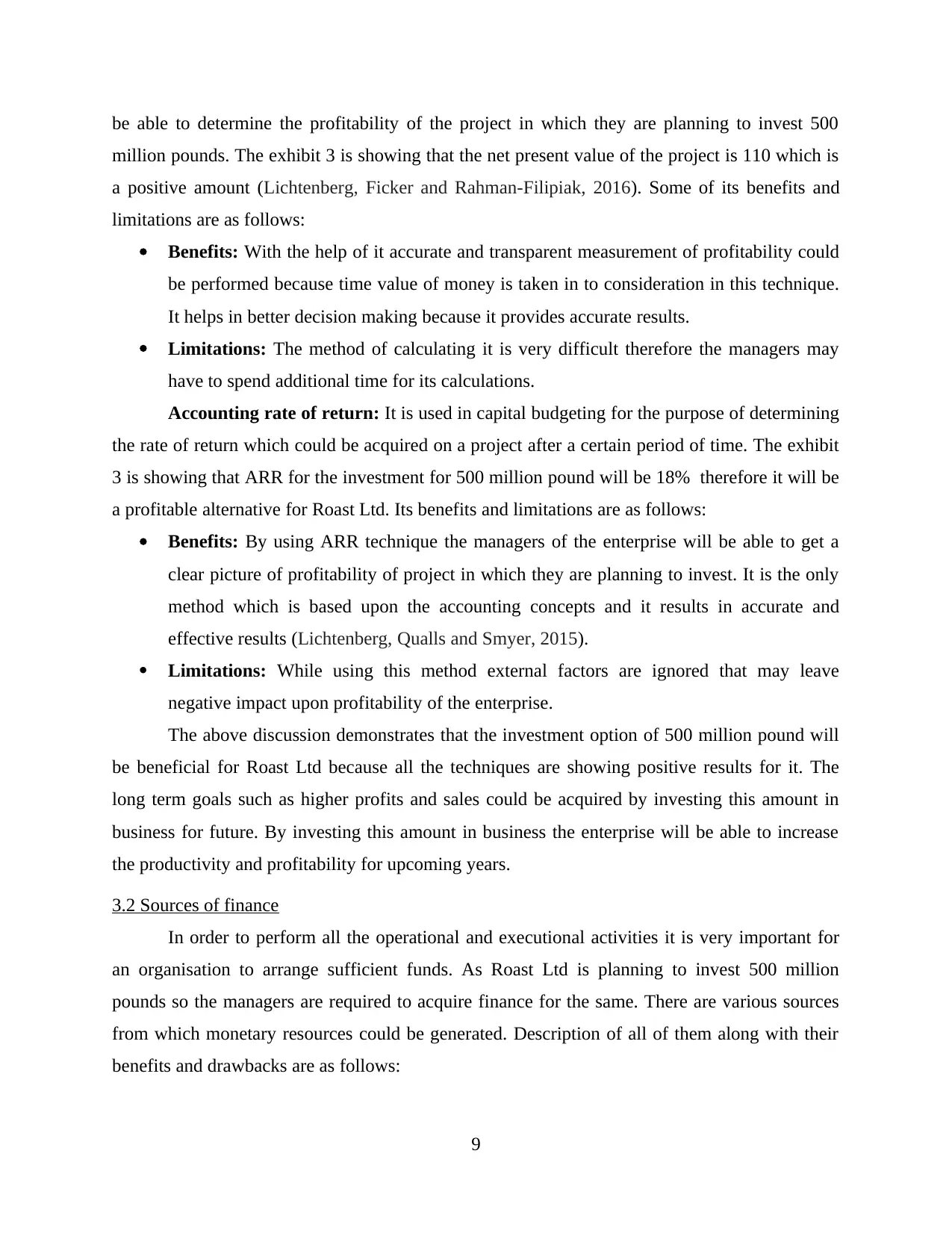
be able to determine the profitability of the project in which they are planning to invest 500
million pounds. The exhibit 3 is showing that the net present value of the project is 110 which is
a positive amount (Lichtenberg, Ficker and Rahman-Filipiak, 2016). Some of its benefits and
limitations are as follows:
Benefits: With the help of it accurate and transparent measurement of profitability could
be performed because time value of money is taken in to consideration in this technique.
It helps in better decision making because it provides accurate results.
Limitations: The method of calculating it is very difficult therefore the managers may
have to spend additional time for its calculations.
Accounting rate of return: It is used in capital budgeting for the purpose of determining
the rate of return which could be acquired on a project after a certain period of time. The exhibit
3 is showing that ARR for the investment for 500 million pound will be 18% therefore it will be
a profitable alternative for Roast Ltd. Its benefits and limitations are as follows:
Benefits: By using ARR technique the managers of the enterprise will be able to get a
clear picture of profitability of project in which they are planning to invest. It is the only
method which is based upon the accounting concepts and it results in accurate and
effective results (Lichtenberg, Qualls and Smyer, 2015).
Limitations: While using this method external factors are ignored that may leave
negative impact upon profitability of the enterprise.
The above discussion demonstrates that the investment option of 500 million pound will
be beneficial for Roast Ltd because all the techniques are showing positive results for it. The
long term goals such as higher profits and sales could be acquired by investing this amount in
business for future. By investing this amount in business the enterprise will be able to increase
the productivity and profitability for upcoming years.
3.2 Sources of finance
In order to perform all the operational and executional activities it is very important for
an organisation to arrange sufficient funds. As Roast Ltd is planning to invest 500 million
pounds so the managers are required to acquire finance for the same. There are various sources
from which monetary resources could be generated. Description of all of them along with their
benefits and drawbacks are as follows:
9
million pounds. The exhibit 3 is showing that the net present value of the project is 110 which is
a positive amount (Lichtenberg, Ficker and Rahman-Filipiak, 2016). Some of its benefits and
limitations are as follows:
Benefits: With the help of it accurate and transparent measurement of profitability could
be performed because time value of money is taken in to consideration in this technique.
It helps in better decision making because it provides accurate results.
Limitations: The method of calculating it is very difficult therefore the managers may
have to spend additional time for its calculations.
Accounting rate of return: It is used in capital budgeting for the purpose of determining
the rate of return which could be acquired on a project after a certain period of time. The exhibit
3 is showing that ARR for the investment for 500 million pound will be 18% therefore it will be
a profitable alternative for Roast Ltd. Its benefits and limitations are as follows:
Benefits: By using ARR technique the managers of the enterprise will be able to get a
clear picture of profitability of project in which they are planning to invest. It is the only
method which is based upon the accounting concepts and it results in accurate and
effective results (Lichtenberg, Qualls and Smyer, 2015).
Limitations: While using this method external factors are ignored that may leave
negative impact upon profitability of the enterprise.
The above discussion demonstrates that the investment option of 500 million pound will
be beneficial for Roast Ltd because all the techniques are showing positive results for it. The
long term goals such as higher profits and sales could be acquired by investing this amount in
business for future. By investing this amount in business the enterprise will be able to increase
the productivity and profitability for upcoming years.
3.2 Sources of finance
In order to perform all the operational and executional activities it is very important for
an organisation to arrange sufficient funds. As Roast Ltd is planning to invest 500 million
pounds so the managers are required to acquire finance for the same. There are various sources
from which monetary resources could be generated. Description of all of them along with their
benefits and drawbacks are as follows:
9
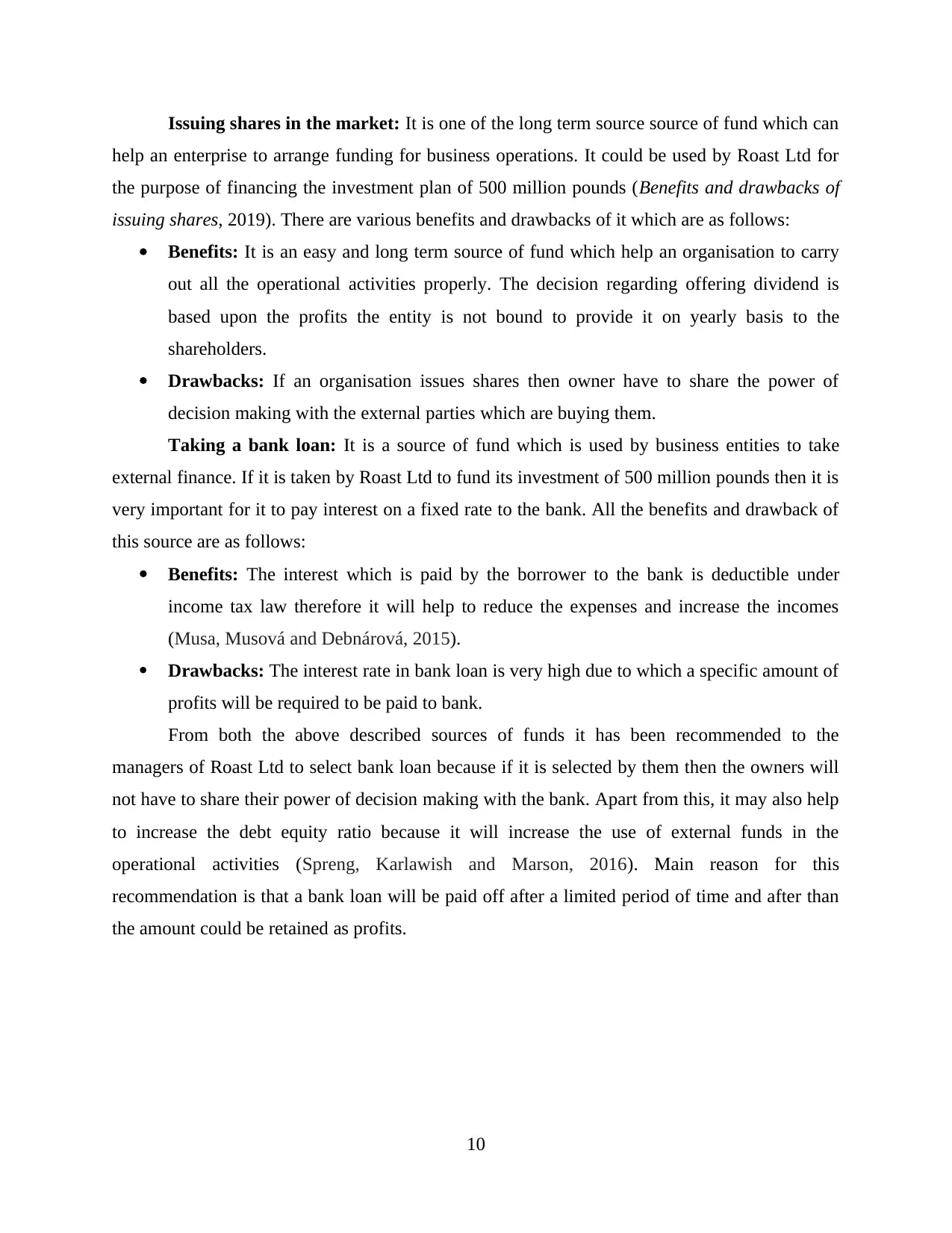
Issuing shares in the market: It is one of the long term source source of fund which can
help an enterprise to arrange funding for business operations. It could be used by Roast Ltd for
the purpose of financing the investment plan of 500 million pounds (Benefits and drawbacks of
issuing shares, 2019). There are various benefits and drawbacks of it which are as follows:
Benefits: It is an easy and long term source of fund which help an organisation to carry
out all the operational activities properly. The decision regarding offering dividend is
based upon the profits the entity is not bound to provide it on yearly basis to the
shareholders.
Drawbacks: If an organisation issues shares then owner have to share the power of
decision making with the external parties which are buying them.
Taking a bank loan: It is a source of fund which is used by business entities to take
external finance. If it is taken by Roast Ltd to fund its investment of 500 million pounds then it is
very important for it to pay interest on a fixed rate to the bank. All the benefits and drawback of
this source are as follows:
Benefits: The interest which is paid by the borrower to the bank is deductible under
income tax law therefore it will help to reduce the expenses and increase the incomes
(Musa, Musová and Debnárová, 2015).
Drawbacks: The interest rate in bank loan is very high due to which a specific amount of
profits will be required to be paid to bank.
From both the above described sources of funds it has been recommended to the
managers of Roast Ltd to select bank loan because if it is selected by them then the owners will
not have to share their power of decision making with the bank. Apart from this, it may also help
to increase the debt equity ratio because it will increase the use of external funds in the
operational activities (Spreng, Karlawish and Marson, 2016). Main reason for this
recommendation is that a bank loan will be paid off after a limited period of time and after than
the amount could be retained as profits.
10
help an enterprise to arrange funding for business operations. It could be used by Roast Ltd for
the purpose of financing the investment plan of 500 million pounds (Benefits and drawbacks of
issuing shares, 2019). There are various benefits and drawbacks of it which are as follows:
Benefits: It is an easy and long term source of fund which help an organisation to carry
out all the operational activities properly. The decision regarding offering dividend is
based upon the profits the entity is not bound to provide it on yearly basis to the
shareholders.
Drawbacks: If an organisation issues shares then owner have to share the power of
decision making with the external parties which are buying them.
Taking a bank loan: It is a source of fund which is used by business entities to take
external finance. If it is taken by Roast Ltd to fund its investment of 500 million pounds then it is
very important for it to pay interest on a fixed rate to the bank. All the benefits and drawback of
this source are as follows:
Benefits: The interest which is paid by the borrower to the bank is deductible under
income tax law therefore it will help to reduce the expenses and increase the incomes
(Musa, Musová and Debnárová, 2015).
Drawbacks: The interest rate in bank loan is very high due to which a specific amount of
profits will be required to be paid to bank.
From both the above described sources of funds it has been recommended to the
managers of Roast Ltd to select bank loan because if it is selected by them then the owners will
not have to share their power of decision making with the bank. Apart from this, it may also help
to increase the debt equity ratio because it will increase the use of external funds in the
operational activities (Spreng, Karlawish and Marson, 2016). Main reason for this
recommendation is that a bank loan will be paid off after a limited period of time and after than
the amount could be retained as profits.
10
⊘ This is a preview!⊘
Do you want full access?
Subscribe today to unlock all pages.

Trusted by 1+ million students worldwide
1 out of 13
Related Documents
Your All-in-One AI-Powered Toolkit for Academic Success.
+13062052269
info@desklib.com
Available 24*7 on WhatsApp / Email
![[object Object]](/_next/static/media/star-bottom.7253800d.svg)
Unlock your academic potential
Copyright © 2020–2025 A2Z Services. All Rights Reserved. Developed and managed by ZUCOL.





